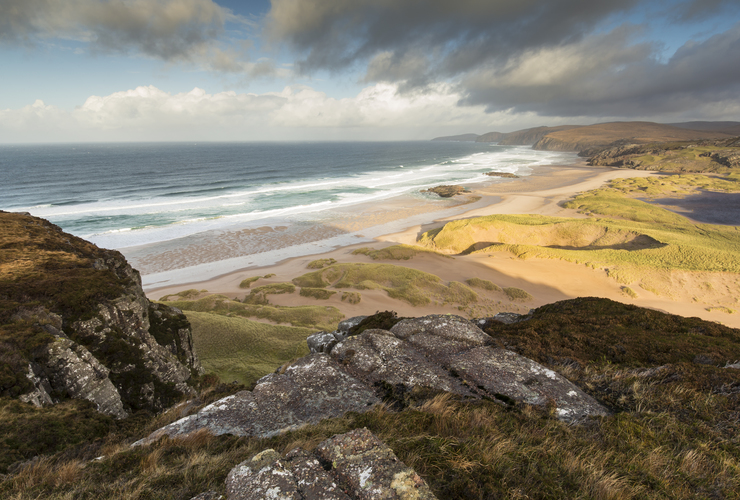Restoring habitats
- Focused efforts to protect the sand dunes and machair in the Sheigra-Oldhshoremore Site of Special Scientific Interest (and Special Area of Conservation) included working with NatureScot and the township Grazings Committee to minimise litter and vehicle impacts from campers:
- The scale of this challenge means further measures will need to be explored in 2022, balancing environmental protection with access for all.
- We also submitted a grant application to stock fence the area and reduce grazing pressure on this rare habitat. - Data from our blanket bog and dwarf shrub heath monitoring shows that the ongoing Moorland Management Scheme in place on Oldshorebeg continues to help protect the health of the blanket bog.
- A pair of nationally rare waders were recorded breeding in Sandwood during the annual sea and moorland bird monitoring exercise. Species identity withheld for protection.
- Fulmars have shown a marked decline this year but other species remain relatively stable. Seabirds on the west coast have generally fared better this season that those on the east, where there were significant Autumn strandings.
- Pipistrelle bats were surveyed as part of annual monitoring at Oldshoremore, numbers appear to be stable.
Working with communities
- We continue to work with the local Leave no Trace Group to install visitor signage regarding fire risks, littering, local amenities and access.
- With the help of six volunteers we removed over 750 kgs of marine litter from one beach. The Highland Council provided a skip.
Collaborating with partners
- A grant from the Royal Society provided two trail cameras. We applied for this grant in order to enable local primary school children to engage with the wildlife on their doorstep:
- Hundreds of images were collected of barn owls at a nest box that was installed near the school
- A camera from the South of Scotland Eagles Project, set up next to a deer carcass, also allowed students to see eagles, ravens, crows, badgers and foxes that visited the carcasses to feed. - Two dolphins and two porpoises found stranded and deceased were reported to the Scottish Marine Animal Stranding Scheme, which aims to provide a systematic and coordinated approach to the surveillance of Scotland’s marine species by collating, analysing and reporting data.
Wild places for all
- Sandwood path maintenance work was carried out in late Autumn by contractors. Work included pitching, ditching, widening and resurfacing the path to protect vulnerable habitat.
- A seasonal ranger, funded by the Nature Restoration Fund, helped to engage and support visitors, remove litter, and carry out visitor surveys to help inform our future engagement work. They helped dismantle 50 fire pits over the season.
- We worked with the Highland Council Tourist Rangers to raise awareness about respectful and responsible camping.
2022 focus
- We will seek funding for a riparian habitat improvement scheme in the catchment of the Shinary river. This is an important area for migratory salmonids, whose populations are in a general decline due to to global warming and industrial fish farming.
- Carry out peatland restoration work, funding dependent.
- Launch a community consultation to progress with the refurbishment of Sandwood carpark (including installing electric vehicle charge points) and the facilities at Blairmor, to ensure these projects benefit the community.
- Increase deer management efforts to protect fragile habitats and promote a more inclusive, community-based approach to deer management.
- We’re exploring opportunities with the local high school to roll out a Sandwood Junior Rangers programme next year, building on the success of the Nevis and Quinag programmes.









